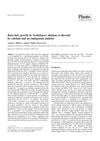TLDR The CAP1 gene helps control ammonium levels and is necessary for the proper growth of root hairs in Arabidopsis.
The study identified CAP1, a receptor-like kinase in Arabidopsis, as crucial for maintaining ammonium (NH4+) homeostasis and essential for the polar growth of root hairs. CAP1 regulated NH4+ transport to the vacuole, maintaining cytoplasmic calcium (Ca2+) gradients necessary for root hair development. Mutants lacking CAP1 (cap1) showed disrupted Ca2+ gradients and impaired root hair growth due to excess cytoplasmic NH4+. Complementation with wild-type CAP1 restored normal growth, confirming its role. The findings underscored CAP1's importance in NH4+ detoxification and root hair development through calcium signaling and nutrient uptake.
612 citations
,
February 2004 in “Nature” OXI1 kinase is essential for plant defense and root hair growth in Arabidopsis.
141 citations
,
June 2002 in “Philosophical Transactions of the Royal Society B Biological Sciences” The study revealed how specific genes and proteins control root hair growth in plants.
 200 citations
,
November 1997 in “Planta”
200 citations
,
November 1997 in “Planta” Calcium affects where root hairs grow, but other unknown factors determine their growth direction.
317 citations
,
August 1997 in “The Plant Journal” Calcium is crucial for sustaining root hair growth in Arabidopsis thaliana.
32 citations
,
May 2018 in “The Plant Cell” ERULUS is crucial for root hair growth by controlling calcium levels.
 December 2017 in “International Journal of Current Research in Biosciences and Plant Biology”
December 2017 in “International Journal of Current Research in Biosciences and Plant Biology” Nutrients and hormones affect root hair growth, but more research is needed to understand the genetic mechanisms.
 2 citations
,
June 2021 in “Notulae Botanicae Horti Agrobotanici Cluj-Napoca”
2 citations
,
June 2021 in “Notulae Botanicae Horti Agrobotanici Cluj-Napoca” More research is needed to understand how nutrients affect root hair growth.
 8 citations
,
July 2022 in “Frontiers in plant science”
8 citations
,
July 2022 in “Frontiers in plant science” pH changes are crucial for root hair growth because they affect enzymes and proteins that control the cell wall and growth.
30 citations
,
October 2020 in “Frontiers in Plant Science” Combined arsenic and low oxygen stress alters root growth to help plants absorb nutrients.
18 citations
,
January 2018 in “Soil biology”



